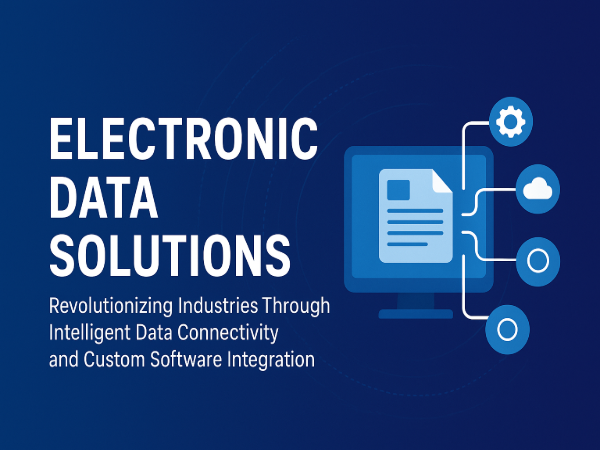Electronic Data Solutions: Transforming How Businesses Capture, Manage, and Transfer Information
Revolutionizing Industries Through Intelligent Data Connectivity and Custom Software Integration

In the modern era, information is the most valuable asset an organization can possess. Every sector — from healthcare to manufacturing, research to retail — relies on accurate, accessible, and secure data. Yet many businesses still struggle with fragmented systems, manual entry errors, and disconnected devices. That’s where electronic data solutions emerge as a transformative force.
Electronic data solutions integrate hardware, software, and intelligent connectivity to collect, process, and transfer data automatically. Instead of wasting time on paper printouts, spreadsheets, or redundant manual entries, these solutions enable seamless communication between instruments, sensors, and enterprise systems. The result is faster decision-making, improved accuracy, and greater operational efficiency.
Companies like Martel Instruments have pioneered this technology by combining custom software and advanced data transfer mechanisms, creating flexible tools that adapt to any environment — from laboratories and industrial plants to remote field operations.
Understanding What Electronic Data Solutions Mean
At its core, an electronic data solution is a system that captures information electronically and makes it available for use, storage, or analysis without manual intervention. It bridges the gap between physical instruments and digital ecosystems.
For example, in a laboratory, devices such as balances, pH meters, or spectrometers generate output readings. Traditionally, this data might be printed, handwritten, or manually typed into a computer. With electronic data solutions, that data is instead transferred automatically to a Laboratory Information Management System (LIMS), a database, or a secure cloud environment.
This shift eliminates human error, speeds up processes, and ensures that critical information is always available when needed. Whether it’s a scientist measuring compounds or an engineer monitoring equipment performance, electronic data solutions make data management seamless and dependable.
How Electronic Data Solutions Work
Electronic data solutions typically include three integrated components:
Data Capture Devices – These devices connect to instruments, sensors, or machinery and record the generated data electronically.
Data Transfer Technology – A secure method (often wired USB, Wi-Fi, Bluetooth, or Ethernet) transfers the captured data to a designated system.
Custom Software Interface – Software interprets the incoming data, formats it according to the user’s needs, and integrates it into enterprise systems or databases.
Modern systems go beyond simple transfer — they can validate data, timestamp records, and comply with industry standards such as ISO, GLP, and FDA 21 CFR Part 11. This makes electronic data solutions indispensable for regulated industries.
The Power of Customization
Not all businesses generate or process data in the same way. A pharmaceutical laboratory has different requirements than a logistics company or a water-quality monitoring agency. That’s why customization is crucial.
Innovative companies design bespoke electronic data solutions tailored to the client’s workflow. Custom software can adapt to specific file formats (PDF, CSV, XML), interface with legacy systems, or include advanced features like automatic backups, audit trails, and user authentication.
This level of personalization means organizations don’t have to overhaul their existing infrastructure; instead, they can integrate new technology that complements what they already use.
Key Benefits of Electronic Data Solutions
Accuracy and Reliability
Manual data entry is prone to mistakes. A single misplaced decimal or transcription error can cause significant financial or safety consequences. Electronic data solutions eliminate these risks by ensuring that information flows directly from the source to the database without alteration.
Efficiency and Productivity
Automation reduces time wasted on repetitive tasks. Employees spend less time recording or verifying data and more time analyzing results, innovating, or improving operations. This not only speeds up workflows but also reduces operational costs.
Compliance and Security
Industries such as pharmaceuticals, food manufacturing, and environmental testing must follow strict regulations. Electronic data systems ensure traceability, data integrity, and secure storage — meeting compliance standards effortlessly.
Scalability
Electronic data solutions can grow with your organization. Whether you’re managing ten instruments or a thousand, modern systems can scale up without losing performance or accuracy.
Connectivity and Integration
Modern data transfer technology allows seamless connection between legacy instruments and new digital ecosystems. Systems can integrate with ERP, LIMS, CRM, or cloud analytics platforms, unifying all data channels into a single digital environment.
Applications Across Industries
Laboratories and Research Facilities
Electronic data solutions revolutionize laboratory workflows by linking instruments directly to management systems. Automated data collection improves precision, speeds up research, and ensures regulatory compliance.
Manufacturing and Industrial Automation
Factories equipped with smart sensors and production monitors can use data solutions to track performance, predict maintenance, and optimize production cycles.
Healthcare and Medical Devices
Hospitals and diagnostic centers use electronic data systems to capture readings from medical instruments, ensuring patient data is instantly stored in electronic health records (EHRs) safely and accurately.
Environmental Monitoring
Water quality, air pollution, and soil monitoring systems rely on electronic data capture devices to collect and transmit readings from remote locations in real time.
Logistics and Supply Chain
Barcode scanners, IoT sensors, and GPS systems integrated with electronic data software provide instant visibility of shipments and inventory, reducing losses and improving delivery accuracy.
The Role of Innovative Companies in Advancing Data Technology
Organizations like Martel Instruments have taken the concept of electronic data solutions to a new level by developing innovative hardware and software designed for real-world adaptability. Their systems connect laboratory instruments, transfer data securely, and convert it into formats ready for digital storage or analysis.
Their approach exemplifies what the future of electronic data looks like: flexible, compliant, and entirely customer-driven. By designing custom interfaces and transfer protocols, they enable businesses to bridge old and new technologies seamlessly.
Challenges and Considerations
While the advantages are clear, implementing electronic data systems requires careful planning. Businesses must consider:
Compatibility with existing instruments and software.
Data security and encryption to protect sensitive information.
User training to ensure teams understand how to operate new systems.
Regulatory requirements that dictate how data is stored and accessed.
A thoughtful strategy ensures that the transition to digital systems enhances operations rather than disrupting them.
Future Trends in Electronic Data Solutions
Artificial Intelligence and Predictive Analytics
Future data systems will not only collect information but also interpret it. AI-driven software will analyze data trends, predict outcomes, and provide actionable insights in real time.
Cloud and Edge Computing
The integration of cloud storage and edge processing will enable faster, more secure data transfer from devices to analytics platforms, even in remote locations.
Internet of Things (IoT) Integration
IoT continues to expand the reach of electronic data systems. Instruments, vehicles, and even wearable devices can become data nodes within a larger digital network.
Enhanced Cybersecurity
As digital connectivity grows, so does the need for robust data protection. Future electronic data solutions will employ stronger encryption, authentication, and blockchain-based verification to safeguard information.
Sustainability and Paperless Operations
By removing the need for printed records, electronic data systems contribute to sustainability goals, reducing paper waste and carbon footprint across industries.
Best Practices for Implementing Electronic Data Solutions
Assess Your Data Needs: Identify what data you collect, where it originates, and how it’s used.
Choose Scalable Technology: Select solutions that can grow with your operations.
Prioritize Integration: Ensure compatibility with your current software and devices.
Focus on Compliance: Especially in regulated sectors, ensure your system meets documentation and audit standards.
Train Your Team: The best technology is only as effective as the people using it.
By following these practices, businesses can implement systems that deliver immediate benefits while preparing for future advancements.
Why Electronic Data Solutions Are Essential Today
The world operates on information. Organizations that still depend on manual or semi-digital methods are at a competitive disadvantage. Electronic data solutions are no longer optional — they’re a strategic necessity.
These technologies reduce human error, improve traceability, and accelerate every stage of the data lifecycle. From capturing a single measurement to managing a global database, they bring consistency, accuracy, and intelligence to every process.
In an age defined by speed and precision, companies adopting advanced electronic data systems position themselves at the forefront of innovation.
Conclusion: Powering the Future of Smart Data Management
Electronic data solutions are transforming how industries work — connecting devices, automating workflows, and empowering decision-makers with real-time insights. Through advanced data transfer technology and customizable software, these systems eliminate barriers between physical instruments and digital intelligence.
The result is a smarter, faster, and more reliable way to handle information — one that supports compliance, innovation, and sustainability. As technology continues to evolve, businesses that invest in adaptable electronic data solutions today will lead the data-driven world of tomorrow.



